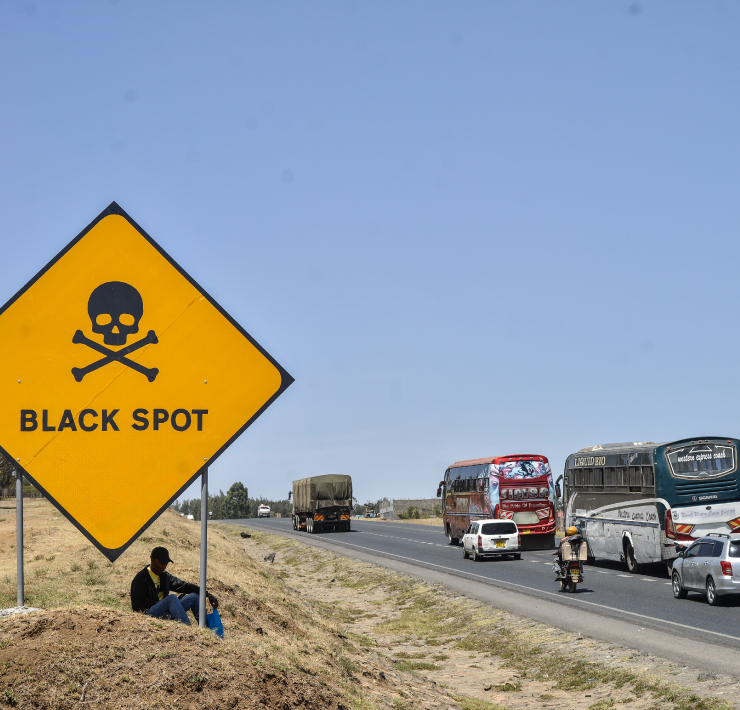There’s a traffic accident reported every hour every day every year in Kenya. As a result of these hourly accidents, between 9 and 11 people die each day. During the same 24 hour period, a further 14 to 29 people will be left seriously injured after a traffic crash. Finally, every day, we can expect up to 33 people to be slightly injured in a traffic accident.
Bear in mind that we are killing the equivalent of a school football team every day in traffic accidents. It all adds up. Amounting to some form of Malthusian population check, almost 5,000 people died in 10,000 reported accidents last year. Every second traffic accident in Kenya will result in a fatality. These are not fender benders; these are a certainty of death and injury on an industrial scale.
The cost to the survivors and the society in medical and other expenses is surely staggering. The numbers of the seriously injured in 2021 alone was just over 10,000 victims. Slightly injured in the same year were another 5,996. In 2016, the World Bank estimated the cost of fatalities and injuries to be 9.1% of GDP and in excess of USD 6 billion. The SGR cost less than this.
You would think that accidents might be more likely during the night, lowered visibility and other conditions would suggest this. But more people have traffic accidents during the day. Of course there is much more driving going on during the sunlight hours, but it seems amazing to read that of the 10,000 accidents reported to the Police in 2021, just over half took place during the day.
There is definitely a quality of driver problem at play. Driver error or fault was responsible for almost 60% of all traffic accidents reported in 2021, the last year I have seen statistics for. This figure includes accidents caused by both motor cars and motorcycles. But do boda boda riders cause more accidents than Kilimani mums? That’s not really clear from the Kenya National Bureau of Statistics data, but we can be certain that private motor cars are primarily responsible for three times as many accidents as motorcycles. Lorries, matatus, buses, and taxis also do three times as much damage as bike riders. That being said, a biker in an accident is far more likely to enter the serious injury category, or worse, than someone driving a caged on four wheels.
There is an entire corpus of law which regulates road traffic and, on paper, punishes errant drivers. The offence of causing death by dangerous driving is fairly well known, at least I thought I knew it until last week when I read news reports of a sentence imposed by a magistrate, after an 11 year trial, on a driver who killed three young adults and maimed a fourth, whilst driving on the wrong side of the road at around 1 a.m.
To begin with, considering the number of accidents that occur, causing death by dangerous driving is not a much charged offence. Latest statistics for 2020 show that there were 290 charges brought against 26 female drivers and 264 men. So I expected that courts would be throwing the book at accused persons. But alas, the courts are imposing sentences that cannot be seen to address the carnage on the roads with any measure of seriousness. The lawyers, defending accused persons, have had it so good that a fine of just over KSh 600,000 for killing three and injuring a fourth was in the estimation of one defence counsel so excessive and draconian that he has promised to appeal against both the sentence and the conviction.
In truth, it appears that causing death by dangerous driving rarely results in jail time, if there are no aggravating factors such as driving under the influence of drink or drugs. Thus magistrates impose a fine as an alternative to incarceration. What shocked me is that, in this particular case, the magistrate imposed a four year jail sentence, with an alternative of a fine of literally KSh 200,000 for each life lost in the accident. My first reaction was to do a rough calculation and wonder how much the convicted driver was being punished by being ordered to pay a fine amounting to less than KSh 430 a day – he got a refund of his bail – spread over four years. That’s equivalent to $3.15 a day.
Considering this to be an outlier miscarriage of justice, I started reading only to find that this fine, as claimed by defence counsel, is much higher than the lawyers were accustomed to under the law prevailing when the accident happened in 2012. Fines have been enhanced since then but may not adequately reflect the gravity of the crime. Speaking to one of the victim’s parents, it was clear that the fine was viewed as a wounding insult – a mother being asked to consider it justice that the driver received a fine of such low value, and had his licence suspended for two years.
This all got me wondering; what is human life really worth in Kenya? A country where the deaths of three promising young men and the maiming of a fourth can be settled by the State in return for $3.15 a day. Clearly, the accused is a man of means. His fine was paid while the court was literally still in session. If a means-test was applied to fines, the man might have felt the punishment more. This would aid him in the future to avoid the reckless streak that got him in trouble in the first place.
Something isn’t right here. And the Judiciary and the Law Reform Commission would do well to review the punishment for the national calamity that is daily deaths on our roads due to dangerous drivers.

